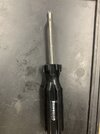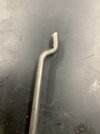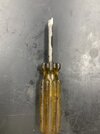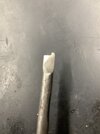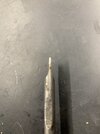If you do choose to redoing the revolver yourself, which really is a fairly simple operation with good You Tube guides like the Brownells or other reputable source, I suggest you make the following rebound slide tool. This is after buying the proper screwdrivers to pull the side plate and the springs from Wolff or other reputable maker:
The Brownells tool is ok, but it is about $18.00 shipped and can be a royal pain to use.
View attachment 1166907View attachment 1166906
Using a $1.00 bargain bin screwdriver and a bench grinder, this shape is much easier to use and much less likely to bend the pin the rebound spring rests against or launch springs across the room.
View attachment 1166903View attachment 1166904View attachment 1166905
This was given to me by the head gunsmithing instructor at Lassen Community College, Bob Chavez, when I took his S&W revolver armorers course. It works to easily remove/install rebound springs on any DA S&W revolver with a swing out cylinder and rebound slide.
Just a suggestion, YMMV.
Stay safe..




